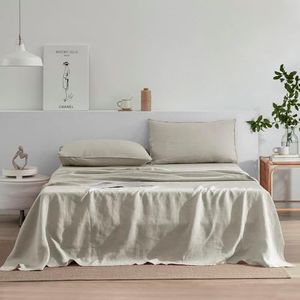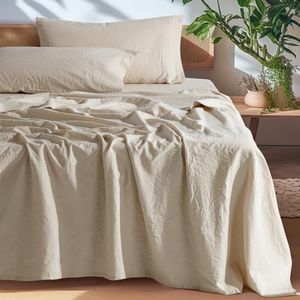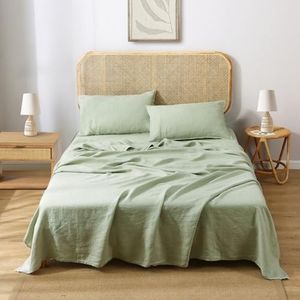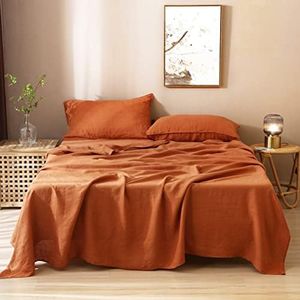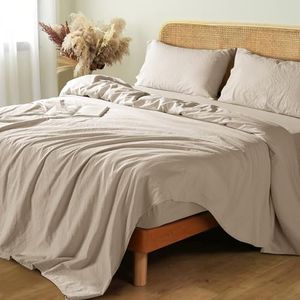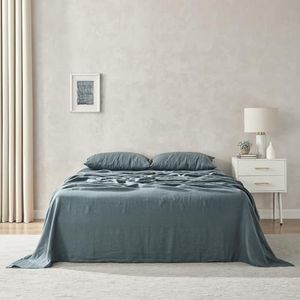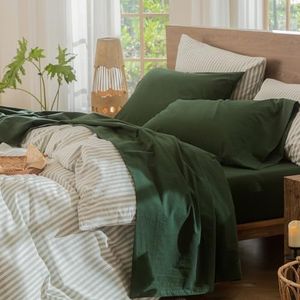We Use CookiesWe use cookies to enhance the security, performance,
functionality and for analytical and promotional activities. By continuing to browse this site you
are agreeing to our privacy policy
10 Best Linen Sheets
From leading brands and best sellers available on the web.Buying Guide for the Best Linen Sheets
Choosing linen sheets can be an exciting way to upgrade your sleep experience. Linen is prized for its breathability, unique texture, and natural durability. To find the best fit for you, it's important to understand the main qualities that set linen apart and which ones matter most for your comfort and lifestyle. Comparing the key features will help ensure you get sheets that suit your preferences, sleep habits, and expectations for longevity and maintenance.Fabric WeightFabric weight is an expression of how heavy or thick the linen fabric is, usually measured in grams per square meter (gsm). This matters because heavier linen is generally more durable and feels cozier, while lighter linen drapes more softly and feels breezier. Lighter weights (around 140-170 gsm) are ideal for people who sleep hot or live in warm climates, as they're airier and cool faster. Medium weights (170-190 gsm) offer a balance of comfort and durability, working well for most people throughout the year. Heavier weights (190+ gsm) are sturdy and last longer but can feel warmer and stiffer at first; these make sense if you like a more substantial feel or plan to use your sheets year-round in cooler environments. Pick a weight based on whether you prioritize coolness, coziness, or longevity.
WeaveThe weave of the linen fabric describes how the threads are interlaced during manufacturing, impacting the feel, appearance, and durability. Most linen sheets use a plain weave, giving a crisp and slightly textured finish, which enhances the breathability and strength of the fabric. Some sheets might feature a sateen or twill weave for a softer, smoother touch, but they may be less airy. If you want maximum breathability and the classic linen feel, go for plain weave. If you prefer a silkier texture and a bit of sheen, consider a sateen or twill, but know this might reduce the signature crispness that linen is known for.
Linen OriginWhere the linen is grown and manufactured can indicate its quality and how it feels. European flax, including from countries like France and Belgium, is highly valued for its long fibers, leading to softer, stronger, and longer-lasting sheets. Linen from other regions may be just as good but can vary more in texture or durability. If you want a reliable standard, look for sheets that mention European flax. If you’re more adventurous or open to different textures, origin might be less critical.
Softness and FinishLinen naturally has a textured or slightly rough feel that softens beautifully with every wash. Some sheets are pre-washed (also called stonewashed or enzyme-washed) so they feel much softer right out of the package. If you love the idea of instant softness and less initial crispness, go for pre-washed linen. If you don’t mind a little roughness at first and want the pleasure of your sheets getting softer with use, untreated options will suit you. Let your patience and preferred texture guide this choice.
Thread CountThread count in linen sheets is less important than in cotton and can sometimes be misleading, as linen’s natural fibers are thicker and don’t require high thread counts to be durable. Typical linen thread counts are much lower (around 80-150) compared to cotton but still yield sturdy, air-permeable fabric. Don’t judge linen sheets by thread count alone; instead, focus on how the sheets feel and their weight. If a brand pushes extremely high thread count, be cautious, as it may not actually result in better sheets.
Care and MaintenanceLinen sheets are known for being low-maintenance, but they can wrinkle easily and require special care to preserve their best qualities. Some linen sheets can be machine washed and tumble dried, while others should be air dried to prevent wear. If you want minimal effort, look for sheets that specify easy care (machine washable and tolerant of dryers). If you value ultimate quality and texture, you might accept the extra step of air drying or ironing. Consider your patience with laundry when making this choice.
Color and DyeLinen sheets come in a range of colors, but how they are dyed affects longevity and health. Oeko-Tex or other certifications indicate that the sheets have been dyed without harmful chemicals. Natural and undyed linen keeps its organic properties and usually ages better, showing a beautiful patina. If you want vibrant colors and modern tones, look for sheets with safe, certified dyes. For a classic, earthy look and maximum eco-friendliness, choose natural or lightly dyed linen.

